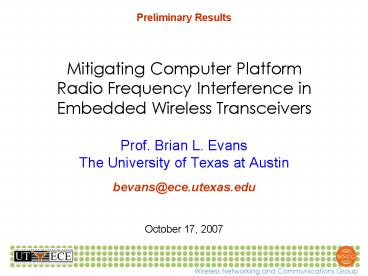Mitigating Computer Platform Radio Frequency Interference in Embedded Wireless Transceivers
Title:
Mitigating Computer Platform Radio Frequency Interference in Embedded Wireless Transceivers
Description:
Develop offline and online algorithms. Approaches. Statistical modeling of RFI ... A. Spaulding and D. Middleton, 'Optimum Reception in an Impulsive Interference ... –
Number of Views:36
Avg rating:3.0/5.0
Title: Mitigating Computer Platform Radio Frequency Interference in Embedded Wireless Transceivers
1
Mitigating Computer PlatformRadio Frequency
Interference inEmbedded Wireless Transceivers
Preliminary Results
- Prof. Brian L. Evans
- The University of Texas at Austin
- bevans_at_ece.utexas.edu
October 17, 2007
2
Computer Platform RFI
- Clocks, clock harmonics, and busses generate RFI
- Impulsive in nature (non-Gaussian)
- Reduces communication performancefor embedded
wireless data transceivers - Goals
- Improve communication performancein presence of
computer platform RFI - Develop offline and online algorithms
- Approaches
- Statistical modeling of RFI
- Filtering/detection using estimation
ofstatistical model parameters
Well be using interference and noise
interchangeably in this talk.
3
Statistical Models
- Middleton Class A
- Symmetric Alpha Stable
Power Spectral Density
Power Spectral Density
with a 1.5, d 0 and g 10
with A 0.15 and G 0.1
4
Middleton Class A Noise
Communication Performance
Class A ParametersA 0.35G 0.5 10-3
5
Symmetric Alpha Stable Noise
Communication Performance
SaS Parametersa 1.5d 0? 1
6
Symmetric Alpha Stable Noise
- 80,000 data samples collected using 20 GSPS scope
Parameter Estimation Parameter Estimation
Localization (d) -0.0393
Dispersion (?) 0.5833
Characteristic Exponent (a) 1.5525
fX(x) - PDF
Normalized MSE 0.0055
x noise amplitude
7
Conclusion
- Modeling computer platform RFI using impulse
noise models promising - Middleton Class A 25 dB gain for BER 10-2
- Symmetric Alpha Stable 5 dB gain for BER 10-1
- Tractable parameter estimation algorithms
- Middleton Class A iterative polynomial
rooting - Symmetric Alpha Stable non-iterative
- UT Austin RFI Mitigation Toolbox
- http//www.ece.utexas.edu/bevans/projects/rfi
- Research began January 2007 more to come!
8
References
- D. Middleton, Non-Gaussian noise models in
signal processing for telecommunications New
methods and results for Class A and Class B noise
models, IEEE Trans. Info. Theory, vol. 45, no.
4, pp. 1129-1149, May 1999. - S. M. Zabin and H. V. Poor, Efficient estimation
of Class A noise parameters via the EM
algorithms, IEEE Trans. Info. Theory, vol. 37,
no. 1, pp. 60-72, Jan. 1991. - G. A. Tsihrintzis and C. L. Nikias, "Fast
estimation of the parameters of alpha-stable
impulsive interference", IEEE Trans. Signal
Proc., vol. 44, Issue 6, pp. 1492-1503, Jun.
1996. - A. Spaulding and D. Middleton, Optimum Reception
in an Impulsive Interference Environment-Part I
Coherent Detection, IEEE Trans. Comm., vol. 25,
no. 9, Sep. 1977. - A. Spaulding and D. Middleton, Optimum Reception
in an Impulsive Interference Environment-Part II
Incoherent Detection, IEEE Trans. Comm., vol.
25, no. 9, Sep. 1977. - B. Widrow et al., Principles and Applications,
Proc. of the IEEE, vol. 63, no.12, Sep. 1975. - J. G. Gonzalez and G. R. Arce, Optimality of the
Myriad Filter in Practical Impulsive-Noise
Environments, IEEE Transactions on Signal
Processing, vol 49, no. 2, Feb. 2001.































